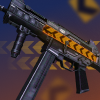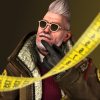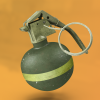The original Mass Effect trilogy is deservedly considered one of the greatest video games in history. The iconic status of Captain Shepard’s adventures wasn’t even compromised by the “traffic light” ending of the third part or by Andromeda, the forth installment in the series that was a comprehensive failure. BioWare managed to create a well-though-out universe with deep lore and compelling characters.

It’s no surprise that the franchise has long since transcended the limits of virtual space and also exists in the form of books, comics, and animation. For many years, fans have been waiting for the promised film adaptation.
The history of the game’s development is chock-full of curious details. But where exactly did the developerss draw inspiration from when they were creating a galaxy full of alien races plunged in Game of Thrones-like twists and turns? Let’s find out.
In the beginning were Star Wars…
While working on various elements of Mass Effect, the developers drew inspiration from various movies, books, and even games, including both masterpieces and not-so-iconic titles. Sci-fi was a particularly rich source of inspiration for Casey Hudson and Drew Karpyshyn, BioWare’s general manager and lead writer of the first Mass Effect, respectively. A truly special place, however, is occupied by Star Wars.
By 2003, BioWare boasted a rich track record and a reputation of talented guys who really could handle third-party licenses. Their loudest and most successful project was Star Wars: Knights of the Old Republic. After those fantastic reviews and gamers’ universal love, their safest option was finishing Jade Empire and switching to a well-deserved rest. Yet the the team chose to move on and started developing their own dream game. Fortunately, they weren’t restricted by any sorts of frames and rules when they envisioned their universe. This allowed them to introduce their own ideas and solutions without hesitation. The project was called Mass Effect.
The works by George Lucas were a massive influence on the developers and their new story. From the very beginning, the creators intended to create a video game analog of Star Wars: a large-scale action movie in space with an epic storyline, designed for three parts and not revealing all the trump cards at once. The title was meant to be an Xbox 2 exclusive, a game worth buying a new console for.
References and allusions to the “galaxy far, far away” can be seen in all parts of the series, not to mention the general style. For example, the biotic magic based on Element Zero is similar to the Force so often employed by the Jedi and the Sith. The appearance of the geth is similar to that of the Separatist droids from the prequel trilogy.
Casey Hudson borrowed the concept of the main character’s karma from KotOR. He wanted to elaborate on how important the decisions made by the player are, affecting the whole world and gameplay. In addition, the system rendered Shepard more unpredictable and interesting to play. After all, not every game features a white and fluffy do-gooder who can punch an annoying journalist. Initially, the team resented the idea because of the huge volume of work that had to be done, but soon enough, everyone got involved and the risks were taken. A side effect of this decision was the transfer of saves, which made the players responsible for their decisions.
The various and not-so-various sci-fi…
When writing the script and developing the design and individual details of the new universe, the creators drew inspiration from works that they enjoyed. These included the iconic creations of science fiction: Babylon 5, Starship Troopers, Firefly, Star Trek, Final Fantasy: The Spirits Within. Casey Hudson himself singled out several other favorite films that also influenced the development: Alien, Blade Runner, and 2001: A Space Odyssey. These inspired a key trait of Mass Effect — its cinematic scale emphasized by the depth of field, the play of light, the style of the picture, and the overall quality of production.
Almost all subtle details and features of the world, such as the appearance of creatures and the designs of buildings, ships, and weapons were — in one way or another — borrowed from these and other works. For instance, when creating the Citadel, the devs relied on the image of the space station from Babylon 5. Some design elements are borrowed from Stanley Kubrick’s The Odyssey, Arthur C. Clarke’s Rama, and Larry Niven’s Ringworld. The closest counterpart to the covert organization SPECTRE is the Rangers from the aforementioned Babylon 5.
Another major source of inspiration was Star Trek. Just like in the films and the TV show that constitute the franchise, the main character’s ship, SSV Normandy, is given a lot of attention, making it feel like an independent character, and the interactions within the crew play a sizeable role in the narrative.
Besides, the studio deemed it crucial to properly convey the spirit of the explorer and pioneer as well as the idea of contact with different alien races and civilizations. Of course, the creators had to work hard to fill the planets with relevant content. Each planet was developed by a separate writer who worked on the local topography, design, and other little things.
It’s not just the design of the station that revels the enormous influence of Stanley Kubrick’s work on the game. At certain moments, the artificial intelligence EDI that controls Normandy behaves quite like HAL-9000 from A Space Odyssey. In one scene, Joker mentions “Daisy Bell,” the song that was sung by the AI in the movie as the protagonist disables its modules. It wasn’t a coincidence that the director chose this particular song, since it was the first time a computer had sung in a human voice. This was witnessed by Arthur C. Clarke, the author of the screenplay and the book of the same name. Incidentally, EDI’s appearance is inspired by Maria from the 1927 movie Metropolis.
The games contain plenty of smaller references to other sci-fi works. The biotic drug “red sand” and the giant worm-like thresher maws refer to Frank Herbert’s Dune. The exterminated insect-like race of Rachni and its last queen are a homage to Orson Scott Card’s Ender’s Game series.
To make the project stand out from the myriad of overly serious and gloomy sci-fi productions, Casey Hudson wanted to create a fairly bright, color-rich universe. To this end, the team designed the locations based on the futuristic art from the 1970s and films Red Planet and Solaris. Those influences are especially prominent in the images of people whose appearance combines the futuristic with the retro-futuristic. That’s why the clothing is quite simple and recognizable, and the gear is full of bulky elements that contrast with that of the more advanced races.
The team of composers, led by Jack Wall, were given the very specific task of creating memorable electronic music in the style of the 70s and 80s that sounded futuristic and modern. The musicians relied on soundtracks from the 80s movies like Blade Runner, Risky Business, and Firestarter. Animator Jonathan Cooper recalled years later that the characteristic frame from behind a character’s shoulder during dialogues was introduced after watching the comedy television series Massive from the writers of Britain’s The Office.
As for games that inspired the developers, the first one to mention would be the Halo series. BioWare made no secret that while working on an early version of Mass Effect, then codenamed SFX, the creators often looked back on the adventures of the Master Chief. However, it all boiled down to borrowing a number of individual elements, as the first attempts at first-person action were but a pale copy of Bungie’s creation. And only the decision to move the camera and turn the project into a third-person game solved the numerous problems with gameplay. The Mako vehicle, used by the crew to explore planets and scan its depths, was inspired by Star Control 2.
We must also mention that Commander Shepard was named after the first American astronaut Alan Shepard — one of the twelve people who were on the Moon during the Apollo 14 mission.
Aliens
The Reapers bear an obvious influence of Howard Phillips Lovecraft’s works. These ancient machines, slumbering somewhere at the edge of space, were guided by motives incomprehensible to other sentient beings. Fear of the unknown and the inevitability of impending danger represent the very gist of the Lovecraftian horror. This effect is further enhanced by their appearance: they are squid-like ships, whose mere emergence can irreversibly change the habitat of an entire planet. Even their creators, the Leviathans, have been hiding in the depths of the oceans for millions of years. The concept of the Reapers was suggested by Casey Hudson, and the rest was the result of Drew Karpyshyn’s creativity. Interestingly, their appearance is similar to that of the Shadows from Babylon 5.
The race of the militaristic turians is based on the Roman Empire and the Samurai. Already their name comes from the word “centurion.” From the Japanese, Garrus’ compatriots inherited a code of honor and a strict military and family hierarchy. The creatures’ appearance is inspired by birds of prey, mostly eagles. While working on their design, the developers constantly wondered what evolved intelligent birds would look like with their feathers lost over time. Hence the menacing appearance, the graceful body, and the clear and aligned movements.
The smart salarians are highly evolved amphibians. The appearance of the big-eyed creatures evokes that of salamanders, vipers, and toads. Behavior-wise, they exhibit a distinctly Oriental influence: they are capable of being both poets and warriors. They were created to ridicule the clichéd images of aliens that had been established in popular culture over the past century.
When creating the asari, BioWare kept in mind the image of exotic alien beauties who look like humans and are universally liked. However, their human-like nature is highly questionable. There’s a curious scene in the game where different races describe the blue-skinned women in different ways. Perhaps they are able to read images in the minds of different creatures and present themselves to them in the most sympathetic way. The deliberately sexualized image of the asari makes them similar to the Twi’leks from Star Wars. The architectural style of the race was inspired by the work of Spanish architect Santiago Calatrava, known for his bio-tech creations.
The Galactic orcs krogan were inspired by common beetles and bats, with features of a piranha head used to lend them more predatory features. For Urdnot Rex’ compatriots, life revolves around war, and very few representatives of the race live to old age or die a natural death. The architectural style of their home planet Tuchanka is inspired by the work of Frank Lloyd Wright, an American architect who promoted organic architecture.
The cosmic nomads quarians aren’t based on gypsies, as you might think, but on the pilgrims from Dan Simmons’ Hyperion series. BioWare conceived them as mysterious star wanderers, traveling all over the galaxy. The other races aren’t particularly happy about their appearance and try their best to get rid of these neighbors as quickly as possible.
Greek mythology
The Mass Effect universe contains a huge number of references and allusions to ancient Greek myths. The most obvious example is the organization Cerberus, named after the three-headed dog that guards the entrance to Hades’ underworld. The Illusive Man’s military forces are equipped with fighting machines called Atlases. That was the name of the mighty titan who bore the vault of heaven on his shoulders.
The discovery of the Charon relay near Pluto allowed mankind to transcend the solar system and enter galactic society. In ancient myths, Charon was the carrier of the souls of the dead along the River Styx.
The planet Ilos is named after the legendary founder of the city of Ilion, better known as Troy. The planet Elysium, with its extremely favorable habitat, was named after Elysium, the part of the afterlife where springtime always reigns and the chosen spend their time free from sorrow and grief.
The image of the Shadow Broker was inspired by Ares, the god of war. The character belongs to the bellicose race of yahg and, like the son of Zeus, is distinguished by his aggressive character and inability to stand strangers. In battle, the Shadow Broker uses a shield — the ancient Greeks almost always depicted Ares with a shield in his hands.
The name “Prothean” comes from the ancient Greek words translated as “the first god.” But most of all, the race of Javik resembles the titans, who gave people various blessings, such as the fire stolen by Prometheus. Likewise, ancient Prothean technology allowed mankind to make a technological leap and reach far beyond its own cradle. Notably, their initial concept resembled the Space Jockeys from Aliens, but their image was then redesigned.
After the failure of Mass Effect: Andromeda, the future of the franchise looked as bleak as it gets. The plans for a new trilogy were abandoned, and BioWare experienced a flop with another project — Anthem. But the studio did find a great way to return the trust of the players. And we want to believe that the Legendary Edition is a probe of the soil before the long-awaited fifth installment.













